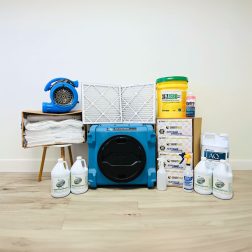Mold Resources
Wood is a staple element of the majority of homes across the country. According to the National Association of Home Builders, over 90% of homes are constructed with this material. As a less expensive and flexible building option, it can be a great asset to any home, from the foundation to the finishings. While an incredibly versatile building material, there is one issue that many homeowners face: knowing how to remove mold from wood.
New homes, older homes, and renovated homes all have the potential for this issue to pop up. Just think of all the wood that’s inside the average home! Each time a beam, floorboard, or windowsill is installed, an opportunity for that fungus among us to grow is created.
That’s why safeguarding our homes and how to remove mold from wood is so important.
Want to learn ways to prevent mold? Check out this article.
How to Remove Mold From Wood
Remediating mold on wood correctly can be tricky. Because of its porosity, the roots of the growing colony can penetrate the surface if not sealed, and it is difficult to remove completely. Small particles like mycotoxins can also embed themselves into the pores of the surface, which are particularly difficult to eliminate.
Hiring a professional for this situation is typically the best option. That way, you can ensure that the issue is resolved and that your home is a safe indoor space once again. HomeCleanse offers revolutionary remediation services. Our approach combines science and advanced technology to remove mold and eliminate mycotoxins and bacteria, leaving your home truly clean and safe. Our mandatory pre- and post-testing guarantees your peace of mind.
That being said, if the mold on wood is a small enough issue that you feel confident in handling, these are the steps you should follow based on whether or not the surface is sealed. Keep in mind that the issue that led to the opportunity should also be resolved, or the microbial growth can return.
How to Remove Mold From Wood If It’s Unsealed:
Use a HEPA vacuum and thoroughly go over the surface:
- Apply 8% hydrogen peroxide and allow this to dry
- Use an abrasive method such as sanding or wire brushing to go over the surface
- HEPA vacuum the surface thoroughly once again
- Spray a botanical cleaner such as Benefect Decon 30 and allow it to sit for 10 seconds
- Wipe with a microfiber towel and then allow this to dry (microfiber towels are 100 times better at wiping away small particles than regular rags)
- Complete the spray, wipe down, and drying process once more using a new side of the microfiber towel
- Dry encapsulate/seal the surface
- When dry, wipe again with a microfiber towel
When you sand and remediate the surface, particles will become airborne during removal. Proper engineering controls, personal protective equipment, and a containment area should be set up to help protect you and your home from cross-contamination.
Make sure to deep clean the home afterward to eliminate these particles and prevent them from spreading to other areas of the space.
We offer a variety of cleaning tools to remove any contaminated particles released by the microbial growth.
Showing all 3 results
-

Mold & Bacteria Contents Cleaning
Remove harmful pollutants that accumulate in the dust of your home. (Options available for renters...
-
$99.00 – $349.00 SHOP NOW -

HomeCleanse Cleaning
Take your cleaning to the next level buying all the tools we use to keep...
-
$299.00 – $549.00 SHOP NOW -

EC3 Laundry Additive
Add EC3 to every rinse cycle to rinse away mold, bacteria and musty odors from...
-
$23.00 SHOP NOW
Next up is knowing how to remove mold from wood if the surface is sealed. These surfaces typically do not require sanding because the roots cannot grow within the wood's fibers. That said, if the mold grows right back, the above process should be followed.
How to Remove Mold From Wood If It’s Sealed:
Spray a botanical cleaner such as Benefect Decon 30 on the surface
Allow this to sit for 10 minutes, then wipe with a microfiber towel.
Repeat the process two more times, flipping the towel to a new side each time
Allow the surface to dry completely
Deep clean the surrounding area
If the situation occurs again, it’s time to call a professional for help. They’ll be able to determine the underlying issue causing the problem. If the mold is on furniture or decor, your best bet is to toss the item and get a new one.
If you need to remove a contamination situation on wood, we offer HomeCleanse DIY Kits! 
Showing the single result
Still Have Questions?
A member of our team is here to help! Click on “Get Started ➤” below to book a consultation with a member of the HOMECLEANSE team. We have a few quick questions that will help us put together a roadmap to solve or prevent all of your mold problems.
Two minutes of your time could lead to better health for you and your family.

